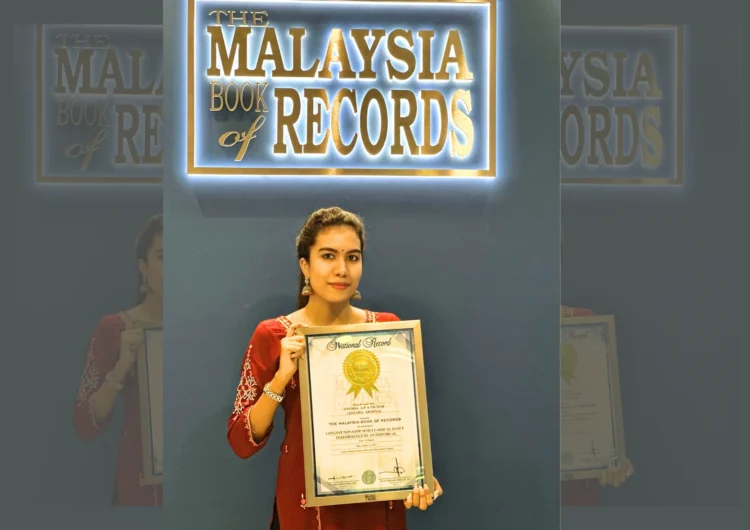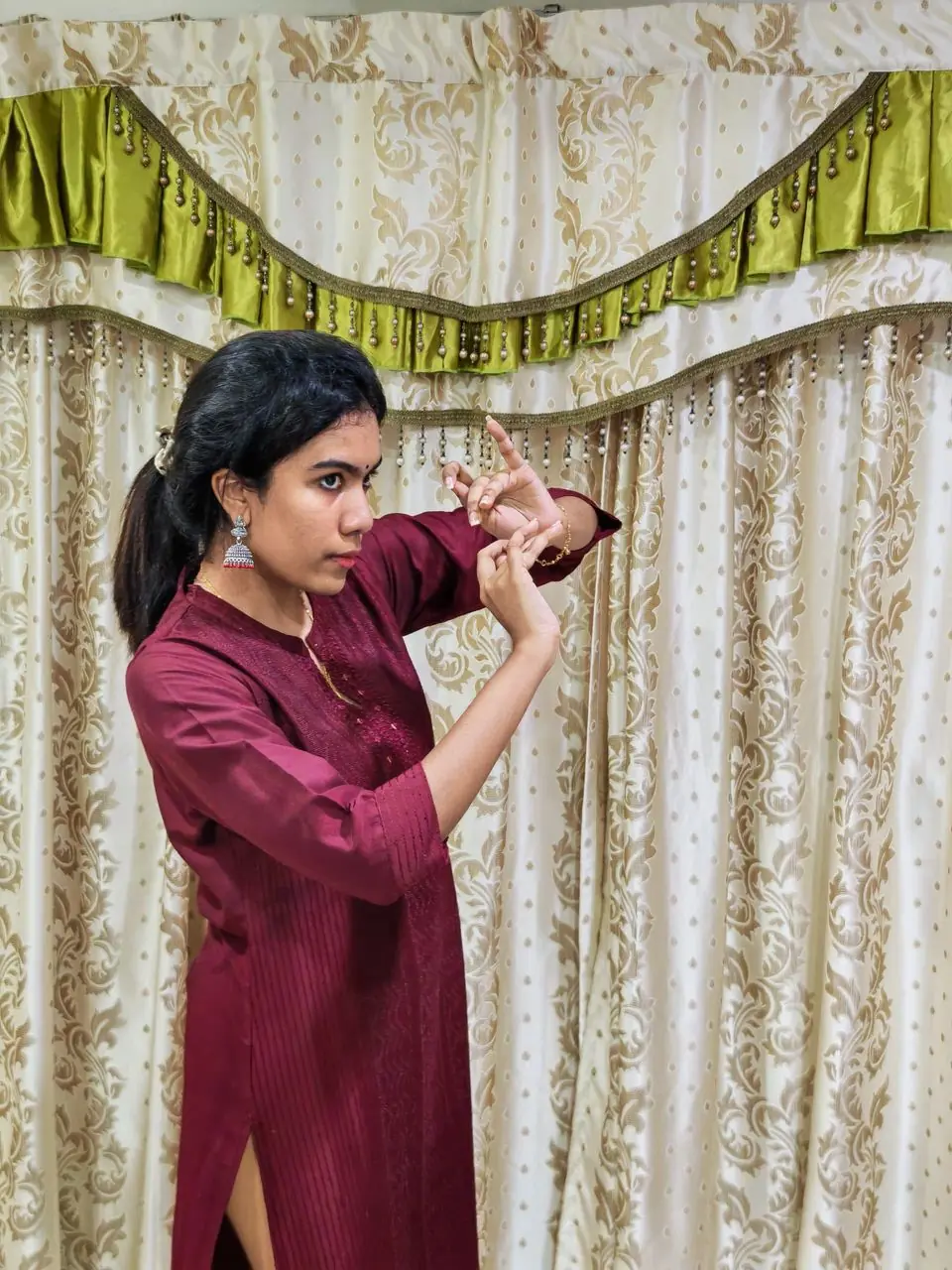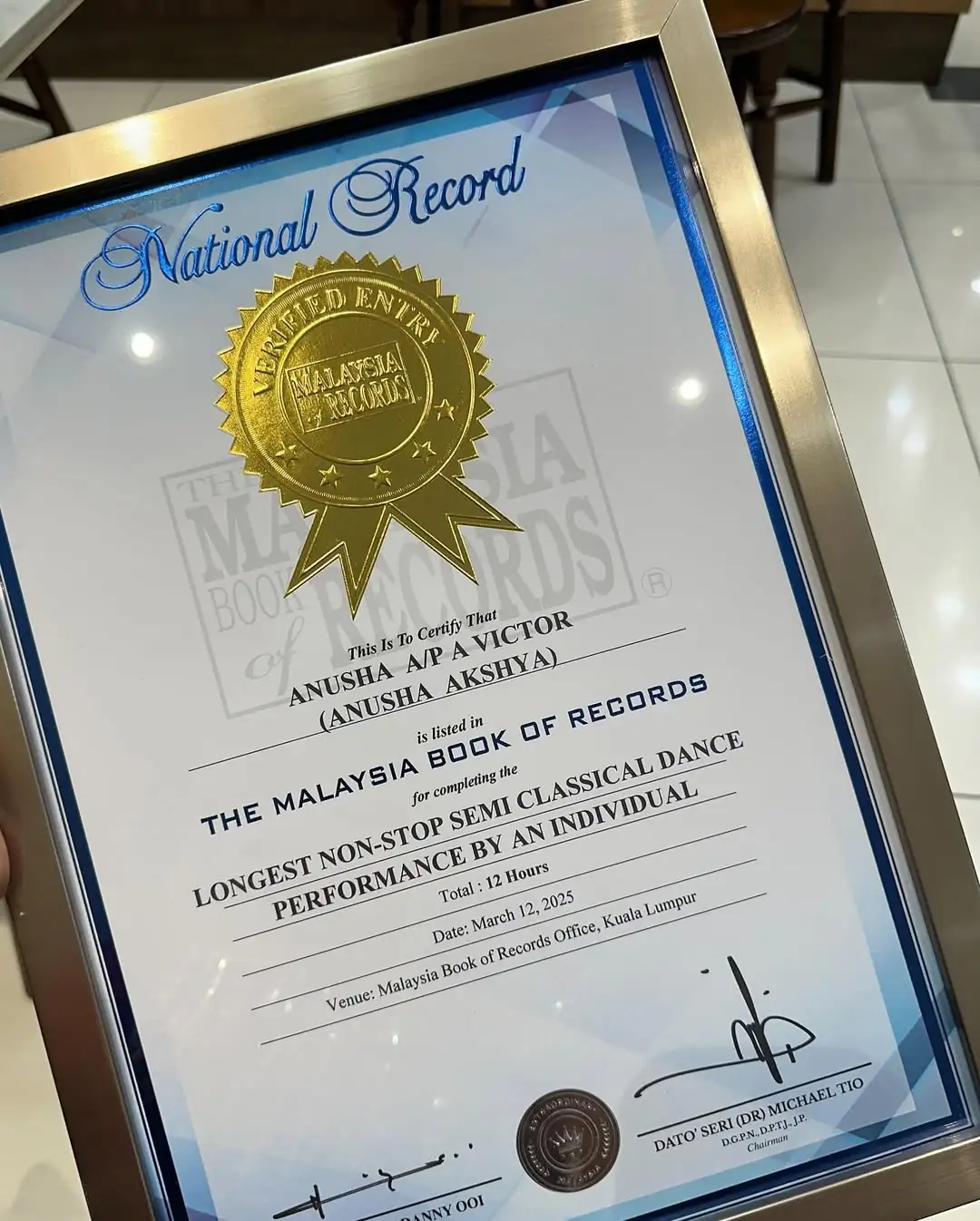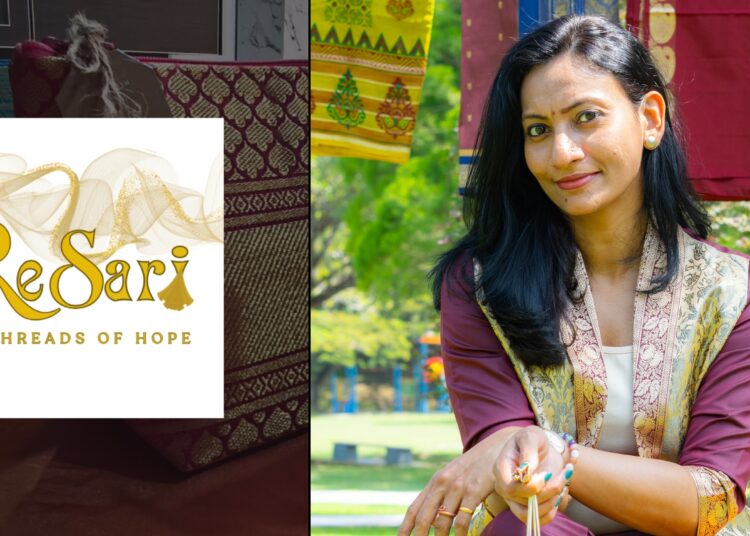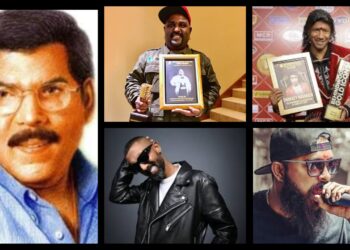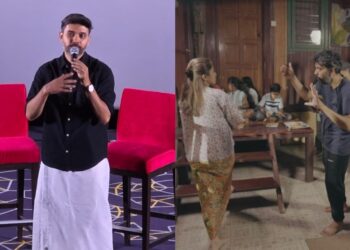In a world where formal training, studio spotlights, and well-connected mentors often define path to artistic success, Anusha Akshya has powerfully written her own script. At just 22, she has achieved something few her age dare to attempt, she entered the Malaysia Book of Records for completing a 12-hour non-stop semi-classical dance performance. Her name now sits among multiple record-holders, but what truly stands out is how she got here, without a stage handed to her but one she built herself.
With no formal dance training, no choreographer to guide her, and no cheering section in the early years, Anusha’s journey has been anything but conventional. But its precisely that path, filled with discipline, solitude, setbacks and self-celebration, that makes her story resonate so deeply. She’s not just a dancer, she’s a symbol of resilience for every young creative who starts from nothing and dares to dream anyway.
Where the Rhythm First Found Her
Before the record-breaking performance, Anusha was just a girl watching YouTube videos, moved by the beauty of movement and emotion. Her love for dance started quietly, not in a studio, but in her own small space, where she learnt her moves herself, and let passion lead the way.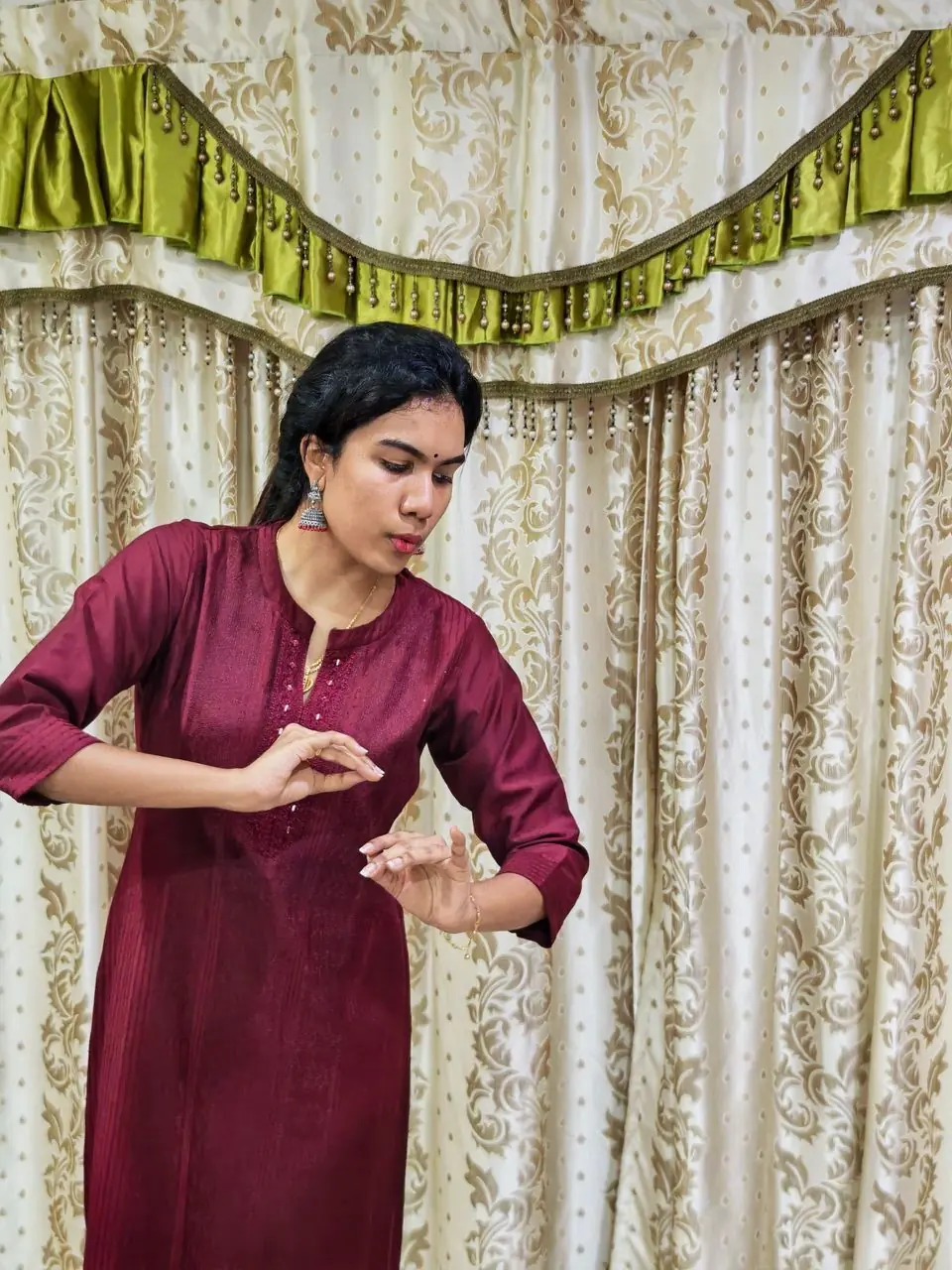
Q: Can you take us back to the beginning, how did your journey with dance first begin? What inspired you to pursue semi-classical dance?
A: My journey began when I was very young. I was always drawn to movement, rhythm, and expression. Watching classical performances on TV and online (YouTube videos) sparked something in me. Even though I didn’t have formal training at first, I would try to learn by observing. Semi-classical dance allowed me to blend tradition with freedom, it gave me space to express myself creatively while still honoring the classical roots
This early curiosity bloomed into something more deeper. While many finds structure in classes, Anusha found creative freedom in imperfection. Semi-classical dance became her language, a way to fuse classical foundation with personal expression.
A Self-Taught Dreamer
Learning anything without guidance is challenging, but learning a performance art like dance, which demands technical precision, rhythm, and expression, is even harder. For Anusha, the absence of a teacher did not hold her back, but it did mean doubling down on self-discipline and learning how to critique herself.
Q: What were some of the challenges you faced while learning dance on your own?
A: Learning on my own was both empowering and difficult. I didn’t have a mentor to guide my posture, expressions, or rhythm, so I had to be my own teacher and critic. Finding the right resources, staying motivated without external support, and ensuring my techniques were correct were big challenges. But it taught me discipline, patience, and how to really listen to my own body
Pushing Beyond the Limit
It takes a bold spirit to turn personal ambition into public record. For Anusha, the decision to attempt a 12-hour non-stop dance wasn’t born from vanity, it was a personal test. A way of proving that passion, when nurtured with persistence, could become palpable. Something more historic.
Q: How did the idea of attempting a 12-hour non-stop dance come about?
A: It started as a personal challenge, to push my own limits and prove that with passion and perseverance, anything is possible. I wanted to do something that not only tested my endurance but also inspired others to follow their dreams, no matter how unconventional their path might be. When I discovered the Malaysian Book of Records, no one has break this record, I knew it was the perfect opportunity to turn that dream into something meaningful
Her choice to challenge a record that no one had set before her wasn’t just about dance, it was about visibility. About showing others, especially self-taught artists, that legitimacy doesn’t come from certificates, it comes from courage.
Training the Mind and Body
The road to this record wasn’t glamorous, it was built in quiet hours of practice, sore muscles, and strict discipline. Preparing for 12 hours of continuous movement demanded more than physical strength, it required mental toughness, emotional control and unwavering focus.
Q: What kind of mental and physical preparation went into setting a Malaysia Book of Records title?
A: A lot. Physically, I had to build stamina, strength, and flexibility. I trained daily, gradually increasing my practice hours. Mentally, I focused on mindfulness and visualization, I had to believe I could do it before my body could follow. I also maintained a strict routine with proper sleep, hydration, and nutrition. The hardest part was staying focused for such a long duration, but mental discipline made all the difference
Each day of training became a ritual. Every step, every sweat, every movement of doubt, it all became fuel for the final performance. When the day arrived, it wasn’t just her body performing. Her whole story danced along with her.
Pushing Through The Pain
Even with preparation, 12 hours of dancing is not easy. Midway through the record attempt, the strain kicked in, physically and emotionally. Its in these moments that most people give up. But not Anusha.
Q: Was there a moment during the dance where you felt like giving up? How did you push through?
A: Yes, there were moments, especially around the halfway mark, where exhaustion started to creep in. My legs were sore, and I could feel my energy dropping. But I reminded myself why I started. I thought about everyone who supported me, and the struggles I have seen in my life. That inner voice was telling me “You’ve come too far to stop now” kept me going
What carried her wasn’t adrenaline, it was memory. Reflection, the weight of her own journey, the sacrifices, and the sheer will to honor her dream until the very last second.
Imagining a Different Path
There were times when Anusha wondered what life would’ve looked like if she had taken another conventional route. Maybe things would’ve been easier. Maybe not, but one thing she knows for sure, she wouldn’t trade her journey for anything.
Q: How do you think your journey would have been different if you had followed a more traditional dance training path?
A: I think a traditional path might have given me technical refinement earlier on and a clear structure. But learning on my own helped me discover my individuality and develop my own style. It taught me to be resourceful and resilient. While I deeply respect formal training, I wouldn’t trade my journey, it made me who I am today.
Her self-taught roots gave her something no textbook could, originality. A rawness that’s deeply personal, and a connection to her craft that’s born out of love, not obligation.
Dancing Without Applause, Then Earning It
Perhaps one of the most powerful parts of Anusha’s story is what happened off-stage. Her journey began without the support of her family. In a world where many rely on loved ones to uplift them, she had to build that support herself, and that’s what makes her achievement even more meaningful.
Q: What has the response been like from your family and the wider dance community?
A: To be honest, I didn’t have the support of my family when I first started dancing. It was difficult emotionally, because pursuing something you’re passionate about without encouragement from those closest to you can be very isolating. But I chose to believe in myself. But I am so grateful for having good friends who was there for me to encourage me to do this. They were very supportive. After achieving the record, my family was so happy and proud, even my father apologised for not believing in me. So many loves from everyone
That moment of recognition, of her father apologising, of her community rallying, became a quite redemption. A reminder that belief in yourself is sometimes the first and hardest, form of validation.
Becoming the Support She Once Needed
Now that she’s built her own platform, Anusha wants to use it for good. Her mission is clear, to uplift dancers who feel unseen, to mentor the ones dancing aline in their rooms, and to remind them that their dreams are valid, even when no one else is sees them yet.
Now that she’s built her own platform, Anusha wants to use it for good. Her mission is clear: to uplift dancers who feel unseen, to mentor the ones dancing alone in their rooms, and to remind them that their dreams are valid, even when no one else sees them yet.
Q: How do you plan to use your platform to inspire or help other young dancers?
A: I want to be the kind of support system I didn’t have. My journey taught me how tough it can be to walk this path alone, so I want to use my experience to uplift others, especially dancers who feel unheard or unsupported. Whether it’s through sharing my story, mentoring, or eventually creating a space where young artists can train, express, and grow, I hope to show them that their dreams are valid and possible, regardless of where they come from or who supports them. Sometimes, all it takes is one voice to say, “You can do this,” and I want to be that voice.
Words to Her Younger Self
Q: Looking back now, what would you tell your younger self when you first started dancing?
A: I would tell her, “You are stronger than you think, and you don’t need approval to chase your passion.” I’d remind her that it’s okay to feel alone sometimes, that every moment of doubt, every tear, every silent rehearsal is building something beautiful. I’d also say, “Keep going, because one day, your journey will be inspiring for others.
What’s Next for Anusha
Even after a national record, Anusha is just getting started. With a heart rooted in storytelling, she’s now turning toward acting, choreography, and creating meaningful art that blends movement with message.
Q: You’ve already achieved a Malaysia Book of Records title, what’s next on your dance journey?
A: For me, dance and acting are both powerful forms of storytelling, and I want to continue blending the two. I’m excited to explore more roles as an actor, especially those that allow me to incorporate movement and emotion through dance. I’m also planning to choreograph more original pieces, collaborate with other artists, and eventually create a space for training and creative expression. Whether it’s through the screen or the stage, my goal is to keep evolving as a performer and use both art forms to connect with people on a deeper level
Anusha Akshya’s story is a reminder that greatness doesn’t need permission. It needs heart. Her journey from self-taught dancer to record-breaking performer is proof that even without recognition, applause or support, a young women can rise. And when they do, they don’t just break records, they break barriers.
All information and images has been provided by Anusha.
This is a Varnam Exclusive Feature! Any Reproduction Requires A Credit To Varnam Malaysia!
Follow us on Instagram, Facebook or Telegram for more updates and breaking news.


